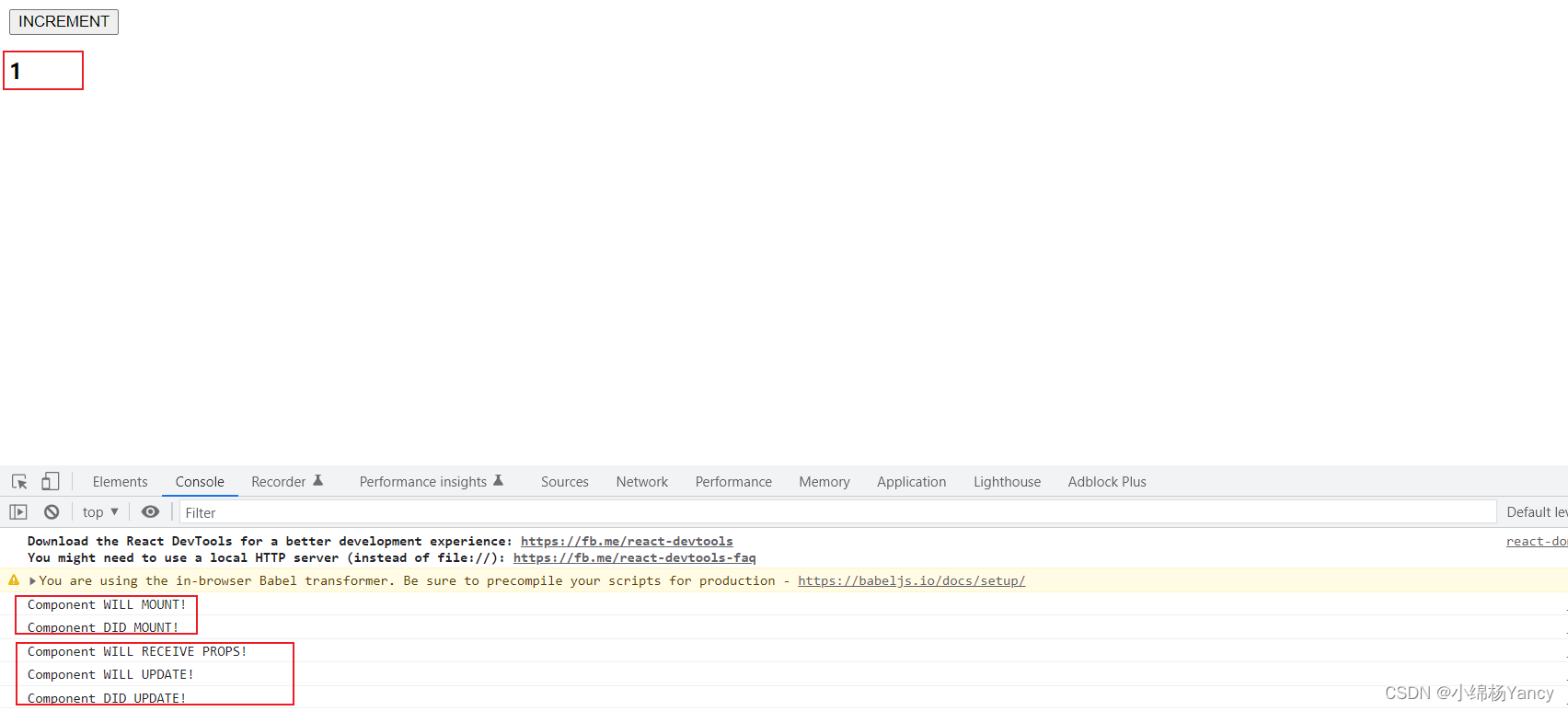在React当中,当你更新组件的state,然后新的state就会重新渲染到页面中。在这个时候不需要你操作任何DOM。这和vue中组件的data中的数据是相似的。
<!DOCTYPE html>
<html lang="en">
<head>
<meta charset="UTF-8" />
<meta http-equiv="X-UA-Compatible" content="IE=edge" />
<meta name="viewport" content="width=device-width, initial-scale=1.0" />
<title>State</title>
<script src="https://cdn.staticfile.org/react/16.8.0/umd/react.development.js"></script>
<script src="https://cdn.staticfile.org/react-dom/16.8.0/umd/react-dom.development.js"></script>
<!-- 生产环境中不建议使用 -->
<script src="https://cdn.staticfile.org/babel-standalone/6.26.0/babel.min.js"></script>
</head>
<body>
<div id="app"></div>
<script type="text/babel">
class Clock extends React.Component {
constructor(props) {
super(props);
this.state = { title: "React State", date: new Date() };
this.handleClick = this.handleClick.bind(this);
}
handleClick() {
this.setState({ date: new Date() });
}
render() {
return (
<div>
<p>{this.state.title}</p>
<p>现在是 {this.state.date.toLocaleTimeString()}.</p>
<button onClick={this.handleClick}>更新时间</button>
</div>
);
}
}
ReactDOM.render(<Clock />, document.getElementById("app"));
</script>
</body>
</html>
类组件需要在constructor中定义this.state对象,其对应的属性就是需要使用的state,例如上面代码中的title和date属性,在render函数中通过this.sate.XXX调用。
注意,修改state需要调用this.setState方法,不可以直接对state进行赋值。
这里的handleClick是按钮的点击事件,点击按钮后,调用setState方法重新为date赋值,此时页面会自动更新。
函数组件没有state => React v16.8.0推出Hooks API,其中的一个API叫做useState可以解决问题。
<!DOCTYPE html>
<html lang="en">
<head>
<meta charset="UTF-8" />
<meta http-equiv="X-UA-Compatible" content="IE=edge" />
<meta name="viewport" content="width=device-width, initial-scale=1.0" />
<title>State</title>
<script src="https://cdn.staticfile.org/react/16.8.0/umd/react.development.js"></script>
<script src="https://cdn.staticfile.org/react-dom/16.8.0/umd/react-dom.development.js"></script>
<!-- 生产环境中不建议使用 -->
<script src="https://cdn.staticfile.org/babel-standalone/6.26.0/babel.min.js"></script>
</head>
<body>
<div id="app"></div>
<script type="text/babel">
const Clock = (props) => {
const [n, setN] = React.useState(0);
function addNum() {
setN(n + 1);
}
return (
<div>
<p>现在的n是 {n} .</p>
<button onClick={addNum}>n+1</button>
</div>
);
};
ReactDOM.render(<Clock />, document.getElementById("app"));
</script>
</body>
</html>可以看到,在函数组件中使用state需要借助useState,并且useState会返回setXXX方法用于修改定义的state,相比于类组件,函数组件更加简洁,而且不用关注修改state时的this指向问题。
组件的生命周期可分成三个状态:
当组件实例被创建并插入 DOM 中时,其生命周期调用顺序如下:
constructor(): 在 React 组件挂载之前,会调用它的构造函数。getDerivedStateFromProps():在调用 render 方法之前调用,并且在初始挂载及后续更新时都会被调用。render(): render() 方法是 class组件中唯一必须实现的方法。componentDidMount(): 在组件挂载后(插入 DOM 树中)立即调用。render() 方法是 class 组件中唯一必须实现的方法,其他方法可以根据自己的需要来实现。
每当组件的 state 或 props 发生变化时,组件就会更新。
当组件的 props 或 state 发生变化时会触发更新。组件更新的生命周期调用顺序如下:
getDerivedStateFromProps(): 在调用 render 方法之前调用,并且在初始挂载及后续更新时都会被调用。根据shouldComponentUpdate() 的返回值,判断 React 组件的输出是否受当前 state 或 props更改的影响。shouldComponentUpdate():当 props 或 state 发生变化时,shouldComponentUpdate() 会在渲染执行之前被调用。render(): render() 方法是 class 组件中唯一必须实现的方法。getSnapshotBeforeUpdate(): 在最近一次渲染输出(提交到 DOM节点)之前调用。componentDidUpdate(): 在更新后会被立即调用。render() 方法是 class 组件中唯一必须实现的方法,其他方法可以根据自己的需要来实现。
当组件从 DOM 中移除时会调用如下方法:
componentWillUnmount(): 在组件卸载及销毁之前直接调用。
<!DOCTYPE html>
<html lang="en">
<head>
<meta charset="UTF-8" />
<meta http-equiv="X-UA-Compatible" content="IE=edge" />
<meta name="viewport" content="width=device-width, initial-scale=1.0" />
<title>Lifecycle</title>
<script src="https://cdn.staticfile.org/react/16.8.0/umd/react.development.js"></script>
<script src="https://cdn.staticfile.org/react-dom/16.8.0/umd/react-dom.development.js"></script>
<!-- 生产环境中不建议使用 -->
<script src="https://cdn.staticfile.org/babel-standalone/6.26.0/babel.min.js"></script>
</head>
<body>
<div id="app"></div>
<script type="text/babel">
class Button extends React.Component {
constructor(props) {
super(props);
this.state = { data: 0 };
this.setNewNumber = this.setNewNumber.bind(this);
}
setNewNumber() {
this.setState({ data: this.state.data + 1 });
}
render() {
return (
<div>
<button onClick={this.setNewNumber}>INCREMENT</button>
<Content myNumber={this.state.data}></Content>
</div>
);
}
}
class Content extends React.Component {
componentWillMount() {
console.log("Component WILL MOUNT!");
}
componentDidMount() {
console.log("Component DID MOUNT!");
}
componentWillReceiveProps(newProps) {
console.log("Component WILL RECEIVE PROPS!");
}
shouldComponentUpdate(newProps, newState) {
return true;
}
componentWillUpdate(nextProps, nextState) {
console.log("Component WILL UPDATE!");
}
componentDidUpdate(prevProps, prevState) {
console.log("Component DID UPDATE!");
}
componentWillUnmount() {
console.log("Component WILL UNMOUNT!");
}
render() {
return (
<div>
<h3>{this.props.myNumber}</h3>
</div>
);
}
}
ReactDOM.render(
<div>
<Button />
</div>,
document.getElementById("app")
);
</script>
</body>
</html>
注意:只有类组件才有生命周期。函数组件每次都是重新运行函数,旧的组件即刻被销毁。
与使用state需要借助useState一样,在函数组件中,我们需要借助可以借助react提供的方法在函数式组件中实现“生命周期”,它就是useEffect。
useEffect 给函数组件增加了操作副作用的能力。它跟 class 组件中的
componentDidMount、componentDidUpdate 和 componentWillUnmount 具有相同的用途,只不过被合并成了一个 API。
<!DOCTYPE html>
<html lang="en">
<head>
<meta charset="UTF-8" />
<meta http-equiv="X-UA-Compatible" content="IE=edge" />
<meta name="viewport" content="width=device-width, initial-scale=1.0" />
<title>useEffect</title>
<script src="https://cdn.staticfile.org/react/16.8.0/umd/react.development.js"></script>
<script src="https://cdn.staticfile.org/react-dom/16.8.0/umd/react-dom.development.js"></script>
<!-- 生产环境中不建议使用 -->
<script src="https://cdn.staticfile.org/babel-standalone/6.26.0/babel.min.js"></script>
</head>
<body>
<div id="app"></div>
<script type="text/babel">
const Clock = (props) => {
const [n, setN] = React.useState(0);
function addNum() {
setN(n + 1);
}
React.useEffect(() => {
console.log(n);
});
return (
<div>
<p>现在的n是 {n} .</p>
<button onClick={addNum}>n+1</button>
</div>
);
};
ReactDOM.render(<Clock />, document.getElementById("app"));
</script>
</body>
</html>
可以看到,上面的使用useEffect时,挂载或者销毁时,都会触发useEffect中的函数,那么如何使用useEffect模拟生命周期呢?
// 只在组件挂载后显示,只需要加个空数组做参数即可
useEffect(() => {
document.title = `You clicked ${count} times`;
},[]);
// 销毁阶段
useEffect(() => {
return ()=>{
console.log("销毁阶段")
}
});可以看到,类组件和函数组件在State和生命周期上区别还是非常大的,函数式组件需要调用react提供的hooks(钩子函数,非常重要,后面会专门学习)来实现类组件对于的功能。
学习过程中,我发现react类组件类似于vue2的选项式api组件,而函数组件则vue3组合式api十分相似。